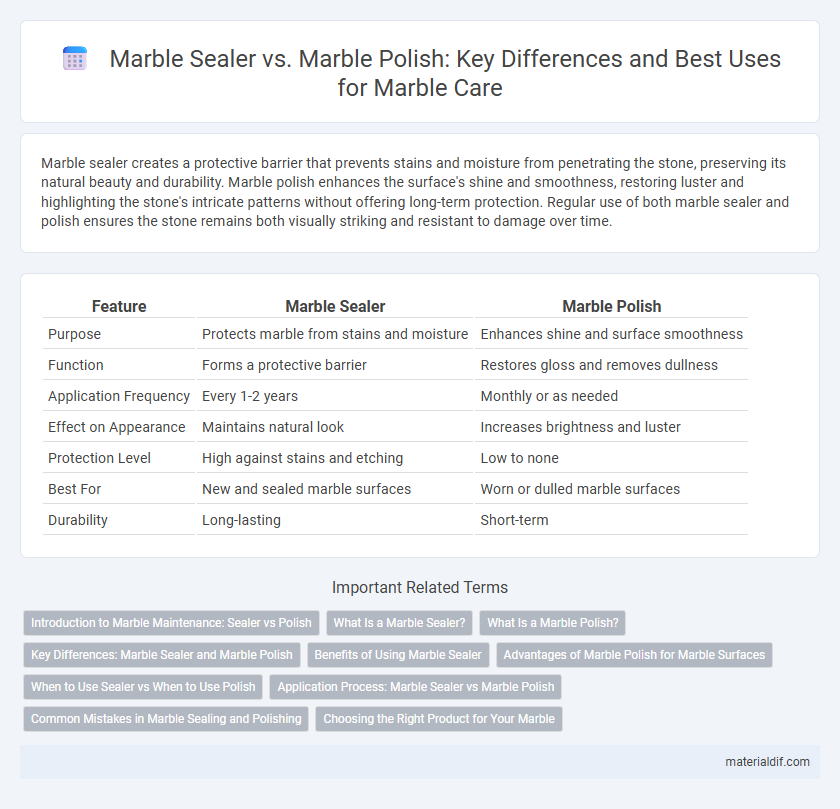Marble sealer creates a protective barrier that prevents stains and moisture from penetrating the stone, preserving its natural beauty and durability. Marble polish enhances the surface's shine and smoothness, restoring luster and highlighting the stone's intricate patterns without offering long-term protection. Regular use of both marble sealer and polish ensures the stone remains both visually striking and resistant to damage over time.
Table of Comparison
| Feature | Marble Sealer | Marble Polish |
|---|---|---|
| Purpose | Protects marble from stains and moisture | Enhances shine and surface smoothness |
| Function | Forms a protective barrier | Restores gloss and removes dullness |
| Application Frequency | Every 1-2 years | Monthly or as needed |
| Effect on Appearance | Maintains natural look | Increases brightness and luster |
| Protection Level | High against stains and etching | Low to none |
| Best For | New and sealed marble surfaces | Worn or dulled marble surfaces |
| Durability | Long-lasting | Short-term |
Introduction to Marble Maintenance: Sealer vs Polish
Marble sealer penetrates the stone's pores to protect against stains and moisture, maintaining its durability and longevity. Marble polish enhances the surface shine by smoothing out fine scratches and restoring the stone's natural luster. Both treatments are essential for comprehensive marble maintenance, ensuring the stone remains both protected and visually appealing.
What Is a Marble Sealer?
A marble sealer is a protective coating designed to penetrate the porous surface of marble, preventing stains, moisture, and damage from penetrating the stone. Unlike marble polish, which enhances the surface shine and restores luster, a sealer creates a barrier that maintains the marble's durability and extends its lifespan. Applying a high-quality marble sealer regularly safeguards the stone from oil, water, and acidic substances, preserving its natural beauty and structural integrity.
What Is a Marble Polish?
Marble polish is a specialized product designed to enhance the natural shine and luster of marble surfaces by filling in microscopic pores and smoothing imperfections. Unlike marble sealer, which primarily provides a protective barrier against stains and moisture, marble polish aims to restore and maintain the stone's reflective finish. Regular use of marble polish helps preserve the aesthetic appeal by reducing dullness and surface scratches without altering the marble's inherent characteristics.
Key Differences: Marble Sealer and Marble Polish
Marble sealer penetrates the stone's pores to create a protective barrier against stains, moisture, and spills, preserving the marble's durability. Marble polish enhances the surface's shine by removing microscopic scratches and restoring the stone's natural luster without providing protective properties. The key difference lies in marble sealer's preventative function versus marble polish's cosmetic enhancement.
Benefits of Using Marble Sealer
Marble sealer provides essential protection by penetrating the stone's pores to prevent stains, moisture, and chemical damage, thereby extending the marble's lifespan. Unlike marble polish, which primarily enhances shine and surface appearance, sealer maintains the natural beauty while safeguarding against dirt and spills. Using a high-quality marble sealer reduces maintenance frequency and preserves the stone's structural integrity in kitchens, bathrooms, and high-traffic areas.
Advantages of Marble Polish for Marble Surfaces
Marble polish enhances the natural shine and depth of marble surfaces while providing a protective layer against minor scratches and stains, maintaining the stone's aesthetic appeal longer than sealer alone. It restores the surface's gloss without altering its breathability, preserving the marble's natural characteristics. By improving resistance to everyday wear, marble polish reduces the need for frequent maintenance and prolongs the lifespan of polished marble floors and countertops.
When to Use Sealer vs When to Use Polish
Use marble sealer to protect surfaces from stains, moisture, and etching by creating a protective barrier, especially on high-traffic areas and porous marble types like Carrara or Calacatta. Marble polish is best for restoring shine, enhancing color, and removing minor scratches or dullness on already sealed and well-maintained marble surfaces. For optimal care, apply sealer during initial installation or after deep cleaning, and use polish periodically to maintain aesthetic luster.
Application Process: Marble Sealer vs Marble Polish
Marble sealer penetrates the stone's surface to create a protective barrier that prevents stains and moisture absorption, typically applied using a brush or roller and requiring drying time between coats. Marble polish, applied with a soft cloth or buffing machine, enhances the stone's shine by smoothing the surface without forming a protective layer. Sealing is essential for stone preservation, while polishing improves aesthetic appeal and surface smoothness.
Common Mistakes in Marble Sealing and Polishing
Applying marble polish instead of a sealer often leads to inadequate protection against stains and etching due to differing chemical properties and intended uses. Many users mistakenly seal marble without thoroughly cleaning it first, causing trapped dirt to degrade the stone beneath the sealer. Overusing sealer can create a sticky surface, while excessive polishing may wear down the marble's surface, diminishing its natural luster and durability.
Choosing the Right Product for Your Marble
Marble sealer penetrates the stone to protect it from stains and moisture, while marble polish enhances its shine by smoothing the surface and filling in minor scratches. Choosing the right product depends on your marble's condition and desired outcome: use a sealer for long-term protection in high-traffic or spill-prone areas, and polish for restoring luster and elegance to worn or dull surfaces. For optimal marble care, combine regular sealing with occasional polishing to maintain durability and aesthetic appeal.
Marble Sealer vs Marble Polish Infographic

 materialdif.com
materialdif.com